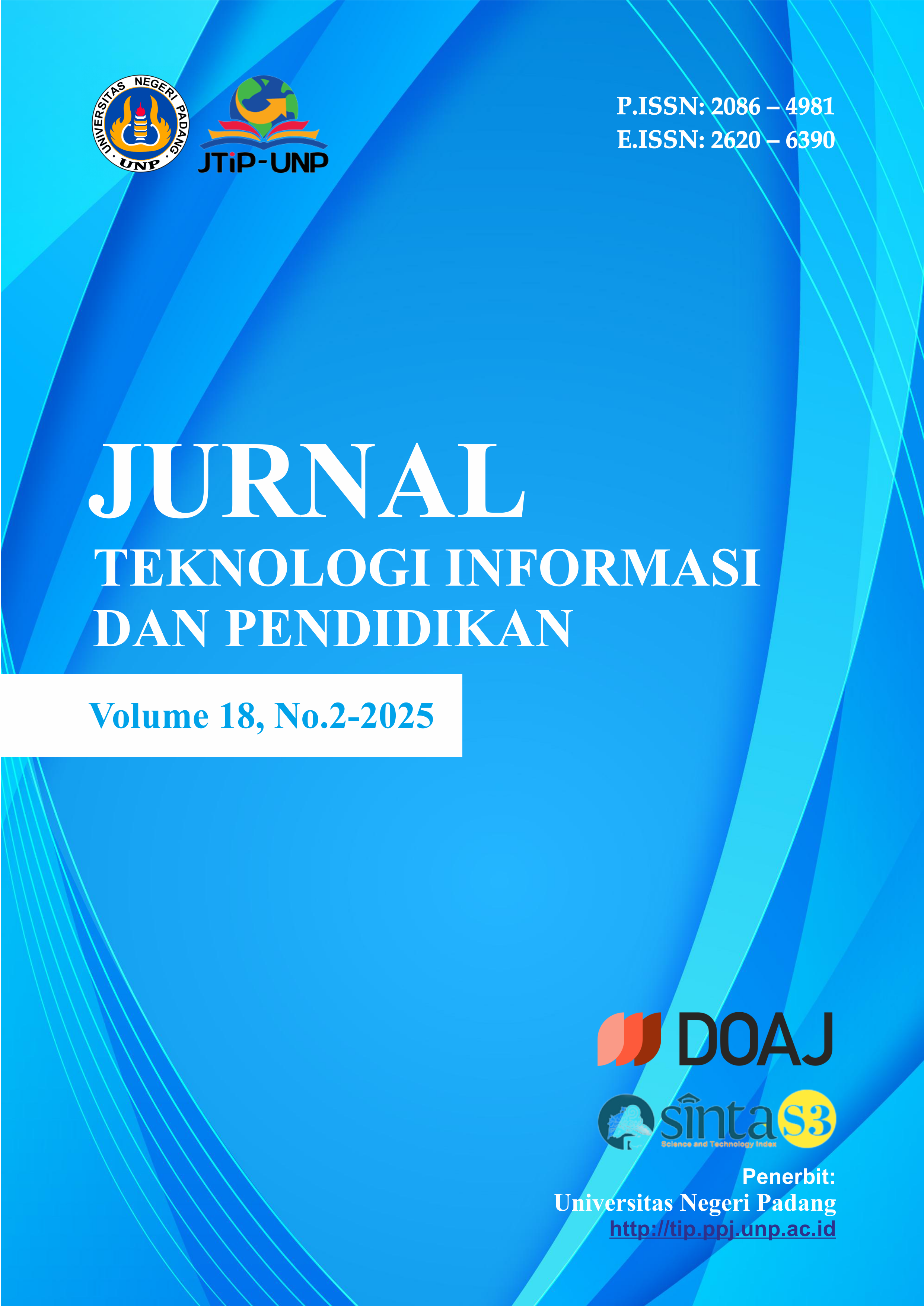Critical Success Factors of ICT Implementation in Vocational High Schools
DOI:
https://doi.org/10.24036/jtip.v18i2.958Keywords:
ICT Implementation, Vocational High Schools, Critical Success Factors, Semi-Structured Interview Method, Case Study Research, Template Analysis, Bengkulu City EducationAbstract
Implementing Information and Communication Technology (ICT) in Vocational High Schools (SMK) plays a crucial role in enhancing the quality of learning, improving administrative efficiency, and preparing students for a technology-driven workforce. However, its implementation still faces various challenges, such as limited infrastructure, the readiness of educators, and uneven policy support. This study aims to identify the Critical Success Factors (CSFs) in ICT implementation in SMKs and analyze the challenges and opportunities for its development. A qualitative approach was employed, utilizing interviews with teachers, school principals, and students from various vocational schools to obtain a comprehensive perspective on ICT adoption in vocational education. The findings reveal eight key factors contributing to the success of ICT implementation: infrastructure availability, teacher competence, the role of school principals, government policy support, student engagement, curriculum integration, digital ethics, and continuous evaluation and monitoring. The study concludes that the success of ICT implementation heavily depends on the synergy between schools, the government, and industry. Therefore, more effective strategies are needed to ensure equitable access to technology, enhance teacher competencies, and strengthen digital-based curricula to optimize ICT to produce competitive SMK graduates in the Industry 4.0 era
References
D. C. Dr. Mahima Gupta, Prof. Banhi Jha, “Use of ICT in Teaching Vocational Subjects,” Inf. Technol. Ind., vol. 9, no. 2, pp. 803–813, 2021, doi: 10.17762/itii.v9i2.417.
S. Kumar, L. V. L. Billa, O. Bhimineni, R. Jaiswal, and A. Bisht, “Implementation of ICT Tools in a Vocational Skill Development Program,” J. Next-Generation Comput., vol. 13, no. 3, 2022.
S. Ghavifekr and W. A. W. Rosdy, “Teaching and learning with technology: Effectiveness of ICT integration in schools,” Int. J. Res. Educ. Sci., vol. 1, no. 2, pp. 175–191, 2015, doi: 10.21890/ijres.23596.
R. K. Mafa and D. W. Govender, “In-Service Science Teacher’s Perceptions Towards the Use of Information Communication Technology Tools in Teaching and Learning in a COVID-19 Environment,” E-Journal Humanit. Arts Soc. Sci., vol. 3, no. 8, pp. 310–322, 2022, doi: 10.38159/ehass.2022383.
D. S. Dewi, E. Waloyo, and T. N. Ria, “the Impact of Technology-Based Learning on Students’Affective, Behavioral, and Cognitive Engagement in Efl Higher Education,” UNNES-TEFLIN Natl. …, pp. 167–179, 2023, [Online]. Available: https://proceeding.unnes.ac.id/index.php/utnc/article/view/2607%0Ahttps://proceeding.unnes.ac.id/index.php/utnc/article/download/2607/2063
I. Warsah and R. Morganna, “The Impact of Collaborative Learning on Learners’ Critical Thinking Skills,” Int. J. Instr., vol. 14, no. 2, 2021.
G.-J. Hwang and P.-Y. Chen, “Effects of a collective problem-solving promotion-based flipped classroom on students’ learning performances and interactive patterns,” Interact. Learn. Environ., vol. 31, no. 5, 2023.
International Labour Organization, Labour Market Analysis for ICT courses at Technical and Vocational Education and Training (BBPLK) Bekasi. 2021. [Online]. Available: www.ilo.org/publns
R. M. Kmurawak, D. Setyaningsih, Y. Tokoro, M. Inggaber, and M. R. Sampebua, “Computer-based Learning Model in Early Schools During the Covid-19 Pandemic in Rural Areas,” J. Teknol. Inf. dan Pendidik., vol. 17, no. 1, pp. 257–270, 2024, doi: 10.24036/jtip.v17i1.652.
K. P. dan K. R. Indonesia, “PembaTIK, Wujud Merdeka Belajar dalam Pemanfaatan TIK untuk Pembelajaran,” kemdikbud.go.id, 2020. https://www.kemdikbud.go.id/main/blog/2020/09/pembatik-wujud-merdeka-belajar-dalam-pemanfaatan-tik-untuk-pembelajaran?
K. A. Ri, B. Litbang, D. A. N. Diklat, and P. T. Administrasi, “e-GOVERNMENT PADA BIDANG PENDIDIKAN,” 2019.
S. Ghavifekr, Ahmad Zabidi Abd Razak Muhammad Faizal A. Ghani, Ng Yan Ran, Yao Meixi, and Zhang Tengyue, “ICT Integration In Education: Incorporation for Teaching & Learning Improvement,” Malaysian Online J. Educ. Technol., vol. 2, no. 2, pp. 24–54, 2014, [Online]. Available: http://www.mojet.net/article.php?volume=2&issue=2&vid=34&article=80
U. International Institute for Educational Planning, “Information and communication technology (ICT) in education,” IIEP Learning Portal, 2023. https://learningportal.iiep.unesco.org/en/issue-briefs/improve-learning/information-and-communication-technology-ict-in-education?
M. J. Z. Lagarbe, “Optimizing ICT Integration in Education: Critical Factors, Pedagogical Strategies, and Policy Implications,” Imjrise, vol. 1, no. 3, pp. 121–126, 2024.
B. N. Tuan, M. Deswina, W. Darwin, and N. Febrianti, “Analysis of Factors Influencing the Decision to Select Thai Nguyen University of Information Technology and Communication,” J. Teknol. Inf. dan Pendidik., vol. 18, no. 1, 2025.
W. (Tsinghua U. Wang and X. (Tsinghua U. Han, “Some Factors Influencing Teachers’ Intention to use ICT in Teaching in Secondary Vocational Schools in China,” Seventh Int. Conf. Educ. Innov. through Technol., 2018.
R. Happy, S. Fauziah, L. Ramadani, and B. Rahmad, “Evaluation of Information System Quality on Electronic Memorandum ( NDE ) System at PT Telkom Indonesia Tbk . Based on ISO / IEC 25010 Standard Dimension Quality in Use ( Characteristics : Efficiency , Satisfaction , and Context Coverage ),” J. Teknol. Inf. dan Pendidik., vol. 17, no. 2, pp. 358–370, 2024.
H. Harrison, M. Birks, R. Franklin, and J. Mills, “Case study research: Foundations and methodological orientations,” Forum Qual. Sozialforsch., vol. 18, no. 1, 2017.
C. Hastings, “A critical realist methodology in empirical research: foundations, process, and payoffs,” J. Crit. Realis., vol. 20, no. 5, pp. 458–473, Oct. 2021, doi: 10.1080/14767430.2021.1958440.
N. D. Kusumawardani, Y. T. Mursityo, and R. I. Rokhmawati, “Evaluasi Critical Success Factors Pada Implementasi Sistem Informasi Supply Chain Management (ALISTA) Menggunakan Metode Dematel Pada PT. Telkom Akses Malang,” J. Pengemb. Teknol. Inf. dan Ilmu Komput., vol. 3, no. 5, pp. 4316–4326, 2019, [Online]. Available: http://j-ptiik.ub.ac.id
P. Widyaningsih, M. Mustafid, and A. F. Rochim, “Perencanaan Strategis Sistem Informasi Pada Institusi Pendidikan Tinggi Menggunakan Analisis Critical Success Factors,” J. Sist. Inf. Bisnis, vol. 1, no. 2, pp. 86–92, 2014, doi: 10.21456/vol1iss2pp86-92.
B. M. Wibawa and M. S. Hakim, “Identifikasi Critical Success Factors Pada Bisnis Pemasaran dan Distribusi,” Pros. Semin. Nas. Manaj. Teknol. XXII, no. January 2017, pp. 1–8, 2015.
E. D. Madyatmadja, L. Kusumawati, S. P. Jamil, W. Kusumawardhana, S. Informasi, and U. B. Nusantara, “CRITICAL SUCCESS FACTOR ADOPSI TEKNOLOGI INFORMASI DAN KOMUNIKASI PADA LEMBAGA PEMASYARAKATAN: SEBUAH STUDI KASUS Mitsal,” INFOTECH J. Technol. Inf., vol. 7, no. 1, pp. 55–62, 2021.
H. Ibrahim, R. G. G. Alam, and D. Abdullah, “Cybersecurity Management Model for A Resilient Smart City Ecosystem,” pp. 1–13.
R. G. G. Alam, H. Ibrahim, and I. R. Karas, “Key Issues in Cybersecurity Implementation in Government Agencies: A Case Study in Jakarta Smart City,” Commun. Comput. Inf. Sci., vol. 2001 CCIS, pp. 3–16, 2024, doi: 10.1007/978-981-99-9589-9_1.
Downloads
Published
How to Cite
Issue
Section
License
Copyright (c) 2025 Jurnal Teknologi Informasi dan Pendidikan

This work is licensed under a Creative Commons Attribution-ShareAlike 4.0 International License.















.png)














